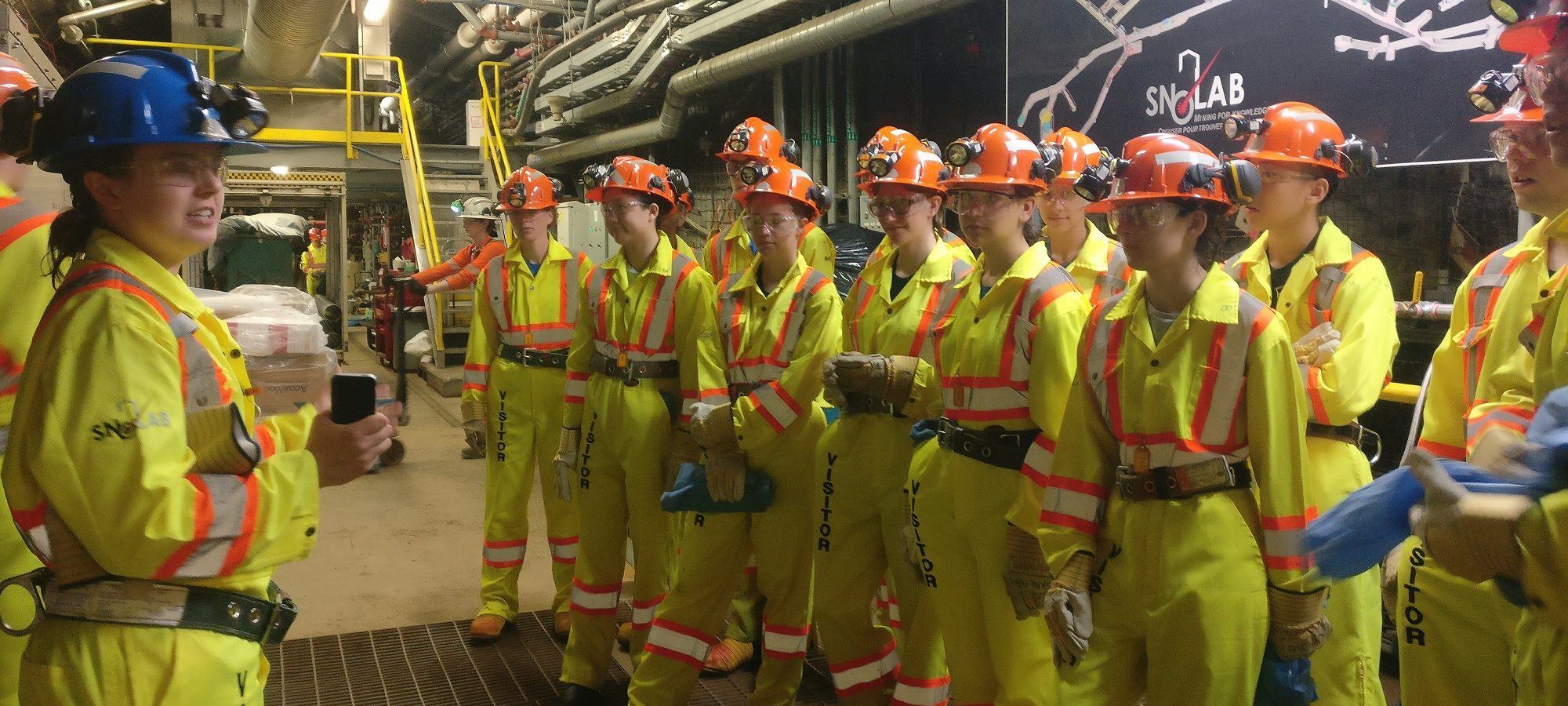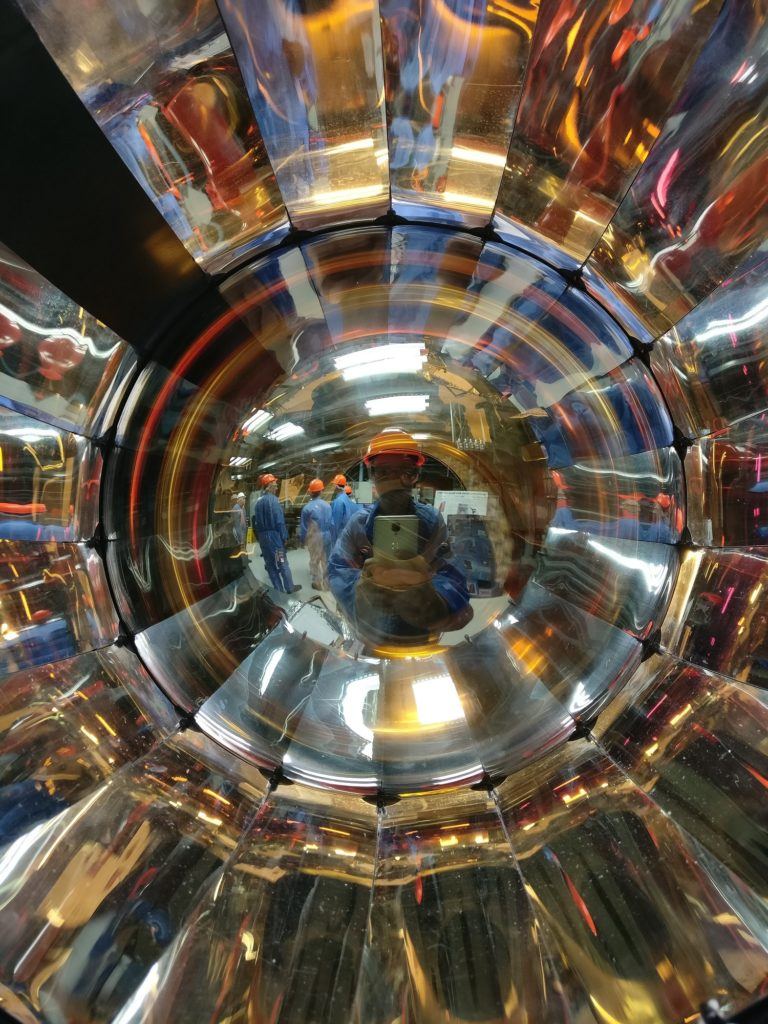Back on the bus with ISSYP
Fifteen years after attending Perimeter’s physics summer school, astrophysicist and science writer Stephanie Keating takes a ride with a new group of teenage physics fans.
Take a self-guided tour from quantum to cosmos!
Fifteen years after attending Perimeter’s physics summer school, astrophysicist and science writer Stephanie Keating takes a ride with a new group of teenage physics fans.

In 2003, at the age of 17, I boarded a bus with 19 other teenagers to visit the Canada’s Wonderland amusement park. Several of us peered intently out the windows, watching a strong breeze cast ripples across a field of long grass and chatting about what kind of interference pattern the ripples might make if they met an opposing breeze, or how we could calculate the speed of the wind.
It wasn’t a field trip for school – it was midsummer and school had been out for several weeks already. Our discussions stemmed from pure, unadulterated interest: the 20 of us were there as part of Perimeter Institute’s “Young Physicists of Canada” (YPC) summer program.
That year was the first time that Perimeter, then a fledgling research institution, invited high school students from across Canada to immerse themselves in theoretical physics for two weeks. I’m sure the staff and researchers involved in running the program must have had some trepidation about getting that many teens together in such a small space (the program was held mostly in Perimeter’s first home: an old clocktower building on Waterloo’s main street). For us, it was a wild success.
The experience had a profound impact on me. Growing up, my interests often diverged from those of my peers. I would rather watch The X-Files than MTV and much preferred to browse Scientific American than a copy of Seventeen magazine. At YPC, I was, for the first time, surrounded by people who shared my quirky interests.

It was incredibly validating. It was also a whirlwind learning experience. We dove off the deep end into brain-bending topics such as relativity and quantum physics. By means of thought experiments and lively discussions, physics came to life. On the roller coasters at Canada’s Wonderland, physics became visceral.
In 2015, I returned to Perimeter Institute, this time as an Outreach Scientist. A year later, I stepped into my current role as a science writer on the Publications team. I discovered that, after the inaugural program that put me on a bus to Wonderland, Perimeter had expanded the summer program to include 20 international students in addition to the 20 Canadians (while still keeping gender parity). Rebranded as the International Summer School for Young Physicists (ISSYP), the program has been going strong ever since.
The structure is much the same: for the first week, students attend lectures on topics including quantum mechanics, relativity, and cosmology. The next week, they break off into small groups to tackle current topics with a physics mentor. Lessons are interspersed with social activities, reflect-and-review sessions, and field trips (which, in some years, include a once-in-a-lifetime visit to SNOLAB in Sudbury, arguably worth sacrificing a few roller coaster rides).
This summer, I revisited my YPC experience when I joined the 15th cohort of ISSYP on their trip to SNOLAB. Their experiences, I found, were remarkably like my own, years earlier. On the bus, I heard groups of students playing cards and other games. Others talked about school, some discussing the cultural differences in their education systems. Still others made physics jokes, talked sports, or debated politics. The emergent picture was one of students who, after just a week together, were already deeply bonded to one another.
Once at SNOLAB, the group suited up and ventured two kilometres underground to learn firsthand about neutrino and dark matter experiments housed at the site of the former Sudbury Neutrino Observatory, home to research that won the 2015 Nobel Prize in Physics. No cellphones are allowed on the way down. In any other group of teens, that might incite an insurrection, but the excitement to visit the facility was palpable, and no-one uttered a word of complaint.
“I had never been underground – not that far, at least – and seeing how the experiments that are trying to discover dark matter are being realized is fantastic,” said ISSYP participant Pedro Henrique Teixeira Tavares, a 17-year-old from São Paolo, Brazil.
Teixeira Tavares appreciated that many participants came from abroad. “I believe that the collaboration between international students is something that is very enriching,” he said. “Some of the people that I met here are probably going to work in the future of physics, are probably going to do research with me.”
For many of the participants, ISSYP is – as it was for me – the first time they have been surrounded by peers who share their passion for science. “It’s like you’re seeing copies of yourself,” explained Vennisa Owusu-Barfi, from Accra, Ghana. “Because you hadn’t ever met any person like you, you’d think, ‘Oh, you’re one in a billion.’ But then you come here, and you see that other people, too, are very similar to you.”
Taylor Walters, from Mill Bay, British Columbia, agreed. “I don’t share a common passion for this with my peers back home,” she said. “It’s always been kind of an independent thing for me.”
But collaboration and teamwork are integral at ISSYP, much as they are in physics research communities. That is part of the program’s power and its appeal. “It was so awesome to communicate with people who had their own ideas, and then I had my ideas which were equally heard,” Walters said. “Together, those ideas became better and really helped us solve the problem. The whole process was really rewarding.”
For many of the participants, ISSYP happens at a critical juncture: right before they head off to university. Indeed, my experience at YPC was part of what inspired me to become a physicist, starting with an undergraduate degree in astrophysics, then a master’s in astronomy (both at the University of Western Ontario), and finally a PhD in astronomy and astrophysics at the University of Toronto.
Teixeira Tavares says his experience at ISSYP has cemented his plan to pursue academia. “The experience here made me realize that it’s exactly what I want to do,” he said.
Walters realized that it just might be possible to forge her own path, one that encompasses her interests in physics, cognitive science, and computer science. Before ISSYP, she wondered if such a goal was unrealistic. Discussions with Perimeter researchers, many of whom rely on interdisciplinary techniques, opened her eyes to new prospects. “I definitely think that finding my own intersection of my passions is really what’s going to drive me forward,” she said.
Owusu-Barfi was inspired by the vast possibilities that physics offers. “There are so many problems that you could explore in physics,” she said. “And, when you solve a problem, you never know – a hundred years later, it could benefit someone.”
Doubtlessly, many of the students aspire to one day return to Perimeter; I know I did, when I was in their shoes. At the time, I dreamed it would be as a researcher, cracking the cases of longstanding cosmic mysteries. Instead, it was as a communicator, sharing the wonder, awe, and excitement of science – a different path, but one that is no less rewarding, and always fascinating.
A round-up of the latest news from Perimeter, a look at the recent work of researchers and alumni, gems from the archive, and fun physics for everyone
Still trying to find the perfect present for the physics lover on your list? Our latest gift guide is sure to inspire. It’s science.
38 participants from 16 countries joined in this year’s International Summer School for Young Physicists, grappling with the complexity of modern physics and building connections that last.